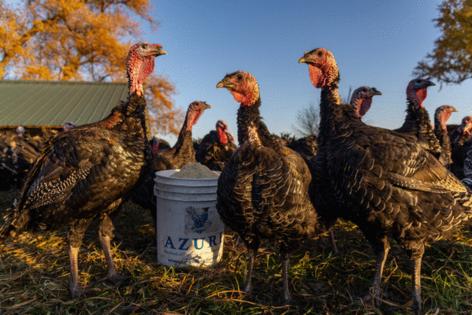Bird flu cases are on the rise again, including 2 million turkeys. Will that affect your Thanksgiving dinner?
Published in News & Features
CHICAGO — Out on his farm in Dundee Township, Cliff McConville sees geese landing in the fields where his turkeys and chickens graze. It’s a sight that often unnerves poultry producers, as migratory waterfowl carry and spread a highly infectious strain of bird flu that has been resurging in the United States for the last three years.
So far this year, McConville’s farm and most turkey farms in Illinois — of which there are more than 400 — have not been affected by the disease. Eight farms in the state have reported cases to the federal government, and only two of those were turkey flocks.
“We raise them outdoors,” McConville said of the poultry operations at All Grass Farms in the northwest suburbs. “They’re going to mix with (wild) birds. So we just have to do our best to keep them healthy. … That’s worked for us so far. Knock on wood.”
But larger turkey-producing states have been hit hard in the past couple of months. Nearly 2 million turkeys have been affected by bird flu across the country since August, accounting for roughly 24% of all new cases in commercial and backyard flocks, even though turkeys only account for approximately 2% of the U.S. poultry inventory.
According to experts, the disease — combined with a drop of almost 10% in turkey meat production from last year, rising labor costs and lower overall consumer demand throughout the year — is triggering higher prices for wholesale and fresh turkeys just ahead of the holiday season. Frozen turkeys are not likely to be as affected.
More than a third of those recent cases came from Minnesota, where, as of Friday, more than 716,000 commercial turkeys have been infected or exposed to the virus since August and over 1 million since the start of the year. Minnesota, which sells a lot of its turkey to Illinois and other states, led the country in production last year with 32 million birds.
It’s not the first time this year that bird flu has disrupted the economy. Following an outbreak last winter, egg prices hit a record high in March. Like turkeys, cases are surging again in egg-laying chickens, with approximately 5.8 million commercial egg layers affected by the disease this fall. Even so, the price of eggs continues to decline from March’s record highs — settling at a nearly 12-month low in September. More recent data on egg prices is unavailable because of the government shutdown.
Since 2022, over 183 million commercial birds have died or been killed in the country as this highly pathogenic strain of avian influenza affects poultry flocks across all 50 states. It has no treatment and continues to be spread by wild birds, causing outbreaks during migratory seasons as they return to their seasonal homes.
“The Upper Midwest, in general, is experiencing a very active highly pathogenic avian influenza season,” said Michelle Kromm, a doctor of veterinary medicine specializing in poultry and public health based in Minnesota. “I think we’re kind of toward the tail end of that activity” this fall.
Even though outbreaks this season appear to be subsiding, spring migration will bring renewed challenges for the poultry industry, especially as it grapples with the recent deaths of turkey breeder hens, which can have longer-term implications.
“Every breeder bird represented multiple turkeys … that are no longer being produced, and it takes a long time to adjust that supply chain,” said Jada Thompson, associate professor of agricultural economics at the University of Arkansas, whose research focuses on livestock health and the poultry industry.
Changes to the turkey market
Experts say customers buying conventional frozen turkeys for their Thanksgiving meal might not feel much of an impact on their wallets because a lot of the meat being sold by large retailers was bought before the fall spike in bird flu. Those who prefer to buy their turkey fresh for the holiday, however, might run into higher prices and fewer available options.
Wholesale costs have shot up 81% from 2024.
“That’s a huge jump,” said David Anderson, professor of agricultural economics at Texas A&M University.
According to the U.S. Department of Agriculture’s latest weekly national turkey market report, wholesale prices for whole turkeys were $1.77 per pound last week comparedwith 98 cents per pound at the same time last year.
In the lead-up to Thanksgiving and Christmas, wholesale costs aren’t expected to come down.
According to agricultural experts, bird flu has been a persistent challenge unlike other temporary market disruptions such as supply chain issues, which often resolve within months. As a result, price forecasts remain raised on “relatively tight supplies,” according to a September report from the USDA’s World Agricultural Supply and Demand Estimates.
As a result of those tight supplies in the domestic market, the United States is buying more from foreign suppliers, with turkey imports jumping roughly 9% month-over-month and more than 33% year-over-year, according to a Tribune analysis of the latest available USDA trade data from July.
On top of that, President Donald Trump’s trade war could be contributing to higher prices domestically. Currently, Canada is the sole country that exports turkeys to the United States, and with its general tariff rate set at 35% for goods not exempt under the United States-Mexico-Canada Agreement, import costs are spiking as well.
“Then you have retail prices,” Anderson said.
Grocery stores have marketing strategies and holiday specials that will probably keep prices lower — and most big chains, he said, contracted their turkeys eight or 10 months ago.
“So their contract price is most likely much lower than what we’re seeing in the wholesale spot market,” Anderson said.
In recent weeks, many stores have started to share their holiday deals and discounts.
According to the latest USDA weekly retail turkey feature activity report, retail prices for frozen conventional whole turkeys are averaging 98 cents per pound — or about 80 cents per pound cheaper than the wholesale market.
The average retail price is also roughly the same as a year ago despite the strain on inventory.
“If they (grocery stores) contracted months and months ago, before prices took off, then that explains it a little bit,” Anderson said.
Typically, the retail price for fresh turkey is higher. According to the latest data, the price of a conventional fresh whole turkey averages about $1.71 per pound nationwide.
And as Turkey Day approaches, the price tag on fresh birds is only increasing.
The average retail price for a whole turkey jumped 12.5% in the second week of November.
“A fresh turkey was going to be harvested pretty close to now, so that it shows up at the store and it has not been frozen or anything. So those are much more related to production right now, which is being hit by bird flu,” he said. “I think that really hits the more fresh, specialty market — probably more than the frozen turkeys that some of us are looking for.”
McConville’s turkeys, for instance, are fresh, pasture-raised and organic, and they sell for $7.95 a pound, which is about the same as the farm’s pricing has been in the past few years.
All Grass Farms raised about 700 turkeys this year — making it a good year, given that more survived than usually do past the young stage. So, even though processing costs went up, the farm has been able to shoulder some of that and remain profitable with the same pricing thanks to its high supply.
The farm always sells out of fresh turkeys in November, he said, the freshest of which they harvest as late as the Monday before Thanksgiving.
“I feel like demand is pretty strong, but it’s not super high,” McConville said. “At least my feeling is not that it’s overwhelming.”
After all, what customers are willing to pay varies.
Some want fresh, such as those raised and sold by McConville and Wanda Farms in Harvard, whose turkeys go for $10 per pound.
“When we’re selling our product on the marketplace, it’s definitely a lot more expensive than if you found a basic turkey at your local grocery store,” said Joe Wanda, owner of the northern Illinois farm. “And that’s just because we’re providing a way better quality turkey that’s going to be just so much better when you cook it up because of the environment that it’s raised (in).”
Other customers would rather stick to more affordable, frozen turkeys: Anderson’s family bought their Thanksgiving turkey last weekend at 87 cents per pound at the local grocery store.
“And I thought, ‘Dang, that’s kind of a good deal,’” the economist said.
Wave after wave of challenges
The recurring market pressures of the bird flu follow the seasonal migration of the waterfowl that carry the disease, both “in the fall and vice versa in the spring,” Kromm said.
As the migratory birds start to “bunch up” or congregate ahead of their travels south, “they swap bugs,” Kromm said — increasing the circulation of the virus.
“This particular strain of influenza continues to be very unique in the fact that it’s sticking around,” Kromm said. It was first detected in spring 2022, and wild birds are still carrying it around with “spillover events” into domestic poultry.
Turkey producers specifically continue to be badly hit by the bird flu. It’s like standing in the middle of the ocean and getting hit by a wave, Thompson, from the University of Arkansas, said.
“So every time you get hit, and you think, ‘I’m recovering,’ you get hit by another wave,” Thompson said.
Because of their growth cycle, the turkey population is also still recovering from losses in the late spring. Many producers raise turkeys throughout the year to stockpile for Thanksgiving, and commercially raised hens, which are preferred for eating, take 16 to 18 weeks to reach maturity and be ready for harvest, said Wanda, the Harvard-based farmer.
The latest surge followed a steep drop-off throughout the summer.
From August to September, the number of birds affected by avian flu in the U.S. jumped a jaw-dropping 6,700%. In August, new cases were reported in only three states — representing less than 57,000 birds. By September, there were confirmed outbreaks in nearly 30 flocks across 10 states, with more than 3.8 million birds affected, according to USDA data.
In October, cases were even more widespread: Nearly 4 million birds were infected or exposed to the virus in 20 states.
A new normal
When birds test positive for avian flu, they are culled, as the USDA has a so-called stamping-out policy, meaning there’s zero tolerance for domestic poultry flocks affected with the virus. So all infected and exposed birds in a flock have to be culled.
“That killing, or what we would call depopulation in the industry, is a really important disease control step, because the birds — especially turkeys, to be honest — they’re pretty sensitive to infection,” Kromm said. “Viruses, being what they are, they require living organisms in order to replicate.”
The government usually purchases the birds that have tested positive from producers to kill them, and sometimes offers financial assistance to clean up barns and farms.
“But that typically doesn’t make everybody whole, and so, cash-flow-wise, it can get to be a big challenge” for producers, Kromm explained.
Biosecurity measures became a “normal course of business” for big commercial poultry operations after the last outbreak in late 2014.
The measures are “pathogen-agnostic,” she said, meaning they protect poultry from a variety of viruses, bacteria and other kinds of germs. “Many of the steps are just best practices for keeping birds healthy, no matter whether we’re worried about highly pathogenic avian influenza or not.”
“So a lot of the regulatory structure and expectations preceded this outbreak,” Kromm said.
But the strain is so contagious that it’s been more difficult to contain with standard precautions.
Now, under the new administration and after mass firings across federal agencies that also affected the USDA — whose Animal and Plant Health Inspection Service unit has lost over 1,300 employees since January — new, less experienced staffers are conducting biosecurity audits, Kromm said.
“You have folks coming out to audit a turkey farm that have never been to a poultry farm, or maybe never even been on a livestock operation. And so they’re coming through with a rubric and having a conversation and checking boxes,” Kromm said. “Sometimes that doesn’t go that well. … There’s a little bit more tension now, I would say.”
She said, however, that she understands the government’s emphasis on accountability and making sure everyone is doing their part to keep the animals safe.
“Ultimately, it’s taxpayers that foot the bill when these flocks break with (bird flu),” Kromm said.
Under Trump, the USDA announced in February it was investing $100 million for vaccine research to curb avian influenza. But vaccinating chickens and turkeys in the United States could affect trade, as importing countries fear asymptomatic birds can still spread infection internationally.
“(The) discussion largely hinges on export markets,” Kromm said. “So those conversations have to be had with trade partners.”
But it can be frustrating for smaller turkey producers who would rather be able to vaccinate their flocks than worry about being able to export their products.
Still, it is exciting to see research and conversation for a vaccine cautiously move forward, Kromm said.
“Because that is a tool that could be helpful in managing this disease,” she said. “Not a cure-all — we think about it similar to COVID vaccines. So it’s an added layer of protection, but that doesn’t mean that you can’t still get COVID, right?”
In the meantime, small farmers in Illinois such as Wanda and McConville have learned to live with the uncertainty, especially when their turkeys spend most of their time outdoors.
While Thanksgiving turkey sales boost their operations, they rely on other sources of income year-round, including beef cattle, broiler chickens and pasture-raised pork.
“We just recognize this is the risk of being a farmer,” Wanda said, “that there are external factors of disease that, potentially, we could get. We just, I guess, gotta pray that we don’t get it. And thankfully — knock on wood — we have not been affected by it.”
____
©2025 Chicago Tribune. Visit at chicagotribune.com. Distributed by Tribune Content Agency, LLC.







Comments